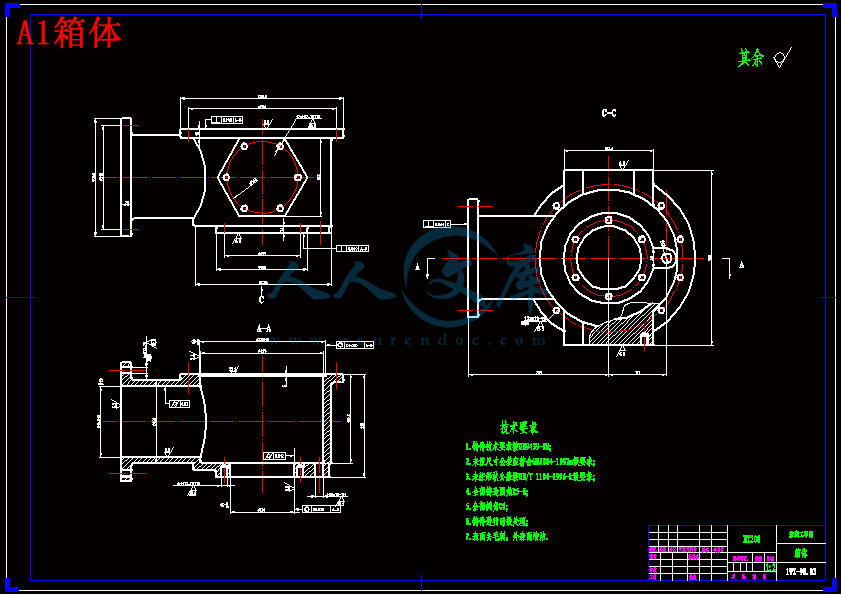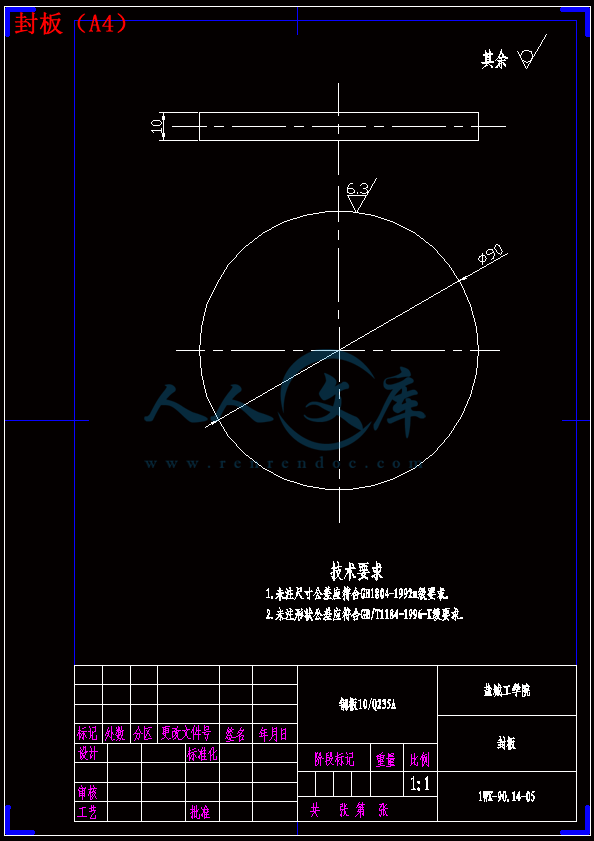【温馨提示】 购买原稿文件请充值后自助下载。
以下预览截图到的都有源文件,图纸是CAD,文档是WORD,下载后即可获得。
预览截图请勿抄袭,原稿文件完整清晰,无水印,可编辑。
有疑问可以咨询QQ:414951605或1304139763
1WX-90型植树挖穴机设计
摘 要:现代新型挖坑机的研发主要向系列化、多功能和高性能方向发展。本植树挖坑机是针对目前使用广泛的江苏50型四轮拖拉机配套而设计的。悬挂式挖坑机采用与拖拉机三点悬挂式联接,即钻头在悬挂支臂的一端,支臂的另一端置于拖拉机悬挂支点上。
本挖坑机主要是对传统的悬挂式植树挖坑机的传动部分和挖掘部分的改进。在主轴箱设计方面,根据江苏50型拖拉机的传动参数,合理的设计锥齿轮的传动比以及强度计算等。在总体设计方面,尽量简化挖坑机的结构,减少其零件数目,以降低成本。对于双螺旋叶片设计,其直径由下往上逐渐减小,其螺旋夹角也由下往上逐渐减小,以避免钻头工作时与塘壁发生碰撞和摩擦等情况,提高了工作稳定性。
关键词:挖坑机;悬挂;双螺旋叶片
1WK-90-Type Planting Excavation Machine
Abstract: The digging machine of modern research and development of new main to the serialization, multi-functional and high-performance direction. The tree digging machine is currently used for a wide range of Jiangsu 50-wheel tractor designed package. Suspended digging machine with a tractor connected to a suspended three-point, that is, the bit at the end of suspension arm, the other end of the arm at the fulcrum of the flying tractor.
The digging machine is suspended from the traditional tree digging machine parts and the transmission part of the improvement of mining. In designing the spindle box, according to Jiangsu 50 tractor transmission parameters, and it needs a reasonable design of the bevel gear transmission ratio and the strength calculation. In the overall design, the digging machine tries to simplify the structure, reducing the number of its parts in order to reduce costs. Blade design for the double helix, whose diameter gradually decreases from bottom to top, the spiral angle also decreases from bottom to top in order to avoid the bit of work with the Tong-wall collisions and friction, etc., increased job stability.
Key words: Digging machine; Suspension; Double helix leaves
目 录
1 引言 1
1.1 本课题的设计意义 1
1.2 国内(外)发展概况及现状 1
1.3 课题由来及设计条件 2
1.4 课题设计思路 3
2总体方案设计 3
2.1整机构介绍 3
2.2 作业原理 3
2.3 挖穴机与拖拉机的联接 4
2.4 挖穴机的动力部分 4
2.4.1功率及挖坑幅度计算 5
2.5 挖坑机主要技术规格和基本技术参数 6
3部件设计 7
3.1 螺旋叶的设计 7
3.1.1 钻头的设计 7
3.1.2 双螺旋叶片的设计 7
4 设计计算 8
4.1动力分配计算 8
4.2 万向联轴器的选用计算 8
4.2.1 万向节总成 8
4.3 齿轮轴 8
4.4 轴承的选用与计算 10
5主要零件强度计算 12
5.1齿轮的校核计算 12
5.2 主轴的校核计算 15
6挖坑机使用和使用中的注意事项 21
6.1挖坑机使用 21
6.2使用中的注意事项 21
7结论 22
参考文献 23
致 谢 24
附件清单 25
1 引言
1.1 本课题的设计意义
近年来,盐城拖拉机制造有限公司发展快速,年产3万台系列轮式拖拉机和8万台手扶拖拉机,销往国内30 个省、市和国外60多个国家和地区。如今,配套农用机具跟不上主机迅速发展的要求。其中包括1WK-50型轮式拖拉机,没有合适农机配套。因此,研制配套挖坑机与拖拉机同步销售,会使得拖拉机,挖坑机两旺。
我设计的是一台植树挖穴机,与黄海金马-50型拖拉机相匹配,用于植树造林及其他的小型挖坑作业。现有的挖穴机多为手提式挖穴机,起工作效率不高,使用条件不便,稳定性能不太理想,因此,本课题设计的植树挖穴机要求工作稳定,工作效率高。随着地球环境的日益恶化,需要大量植树造林,改善环境,因此,研制经济高效的植树挖穴机将深受广大人名群众的欢迎。
1.2 国内(外)发展概况及现状
中国挖穴机产业发展出现的问题中,许多情况不容乐观,如产业结构不合理、产业集中于劳动力密集型产品;技术密集型产品明显落后于发达工业国家;生产要素决定性作用正在削弱;产业能源消耗大、产出率低、环境污染严重、对自然资源破坏力大;企业总体规模偏小、技术创新能力薄弱、管理水平落后等。
我国植树造林机具现状我国植树造林机械赴较晚,主要在南方为种植橡胶实现产业化,有为东方红-75、热特-25型拖拉机配套的挖穴机,而北方地区为栽植果树和防护林,也研制了为中型轮式拖拉机如上海-50、神牛-25型拖拉机配套的开沟机、挖穴机,这种机具既可以挖植树穴坑,也可以挖梯形沟槽用于果树施沟肥。对大面积的机械植树造林,多采用铧式系歹开沟机,如1K-40、1K-50和1K-60型开沟机。我国植树造林机械虽有多个品种,但由于栽种树苗多在山地、坡地,土质条件复杂,影响了机械的使用效果,基本上用人工挖坑栽苗,生产的挖穴机批量较小。近几年来,由于经济林的兴起以及国家为防治水土流失,退耕还林、种草种树已引起各有关部门的普遍重视,并加大了植树造林机械的投入,取得了良好的效果。
挖穴机为了适应不同土壤、不同作业条件的要求,国外生产的不同动力配套的造林用挖穴机,有手提式、背负式、手扶拖拉机式和拖拉机式4种。
A.手提式挖穴机,分为单人式与双人式。日本多用单人手提式,欧洲各国则多采用双人手提式。手提式挖穴机发动机的功率一般为1.3--3.7kw,多采用油锯和割灌机的单缸风冷汽油发动机为动力。单人和双人手提式挖穴机发动机的转数经离心式离合器和减速箱,将转数降低到100--200r/min,再传到挖穴钻头。由于减速比很大,多采用蜗轮蜗杆或摆线针轮行星传动机构,以便减少机器的质量。由于双人手提式挖穴机质量可以大一些,有的采用多段直齿轮减速机构。有的挖穴机为了使挖穴机钻头能自动地由地中拔出,在传动机构中装有逆转机构。国外所用的挖穴钻头多为螺旋片型,挖穴时自穴中向上排土的性能好,螺旋片型有单螺旋和双螺旋两种。山地造林时,挖穴的直径和深度为25--30厘米,因此多采用1.5--2个节距的螺旋片。为了提高螺旋片型挖穴机的切根性能,有的将螺旋边缘做成缺口状。国外所用挖穴机钻头的转数都不太高,以免将穴中的土壤甩得过远,一般周边速度为3米/秒左右,钻头转数为200--300r/min。装有逆转机构的挖穴机在拔出钻头时,土壤会向相反方向旋转,不会从穴中抛出。手扶拖拉机式挖穴机的功率为3.7--7.3kw,轮式拖拉机挖穴机的功率为36.8--73.6kw。
B.悬挂式挖穴机主要用于栽植大树苗时的挖穴作业,挖穴直径为50--80厘米,挖穴深度为60厘米,挖穴机悬挂在25.7--58.8kw拖拉机上。挖穴机由纵吊杆、带安全装置的万向传动轴、减速器和不同直径的挖穴钻头组成。减速器由一对直齿锥齿轮组成,更换不同直径的挖穴钻头时,要更换不同的锥齿轮,可换挖穴钻头有3种,直径分别为80、60、30厘米。钻头由空心钻杆、叶片和切土刀片组成,钻杆下端有定心尖。工作时,由拖拉机动力输出轴经万向传动轴带动旋转工作部件完成挖穴作业,利用液压装置控制钻头升降。
C.液压式挖穴机在发达国家已普遍推广。由于液压技术的普及推广,发达国家在挖穴机上已采用液压传动装置,主要用在液压输出能力较强的拖拉机或挖掘机的机型上,用液压泵驱动齿轮机构传动系统。DANUSER液压挖穴机装有高效、转向密封性能好的液压马达,可调节机械链条与齿轮,使扭距增大4倍。采用液压驱动比用万向节套管传动更灵活方便,当遇到障碍物时能起到安全缓冲作用。
1.3 课题由来及设计条件
A.设计内容
设计一台植树挖穴机,与黄海金马-50型拖拉机相匹配,用于植树造林。主要的设计内容有:
a)总体设计:设计总体方案。绘制挖穴机总图;
b)零部件设计:根据挖坑机总图,设计齿轮箱等传动机构;绘制传动轴、齿轮、齿轮箱体、钻头等零件图;有关计算、校核等。
B.设计依据
a) 相配套的江苏-50型四轮拖拉机主要技术数据
①力输出轴转速:720r/min; 540 r/min
②动力输出轴离地高度:645mm
b) LY/T1491-1999,悬挂式挖穴机 技术条件[S].
c) 挖穴机技术参数
①挖穴直径:70cm
②挖穴深度:70cm
③钻头转速:150~250r/min
④钻头形式:采用双螺旋叶片结构;
⑤工作效率:60~90坑塘/小时
⑥按5年寿命,每年工作800小时计。
C.设计要求
a) 挖穴机与拖拉机采用三点悬挂联接, 作业时万向传动轴偏置角度不得大于15°,田间移位或运输前必须先切断动力,将螺旋钻头提升至最大高度,此时钻头顶尖离地高度应大于300mm。
b) 螺旋叶片的转速过高,会将泥土抛得很远,造成填坑缺土。转速过低,则造成工作效率不高。因此在设计时,要充分调研和实践,确定合适的转速,
c) 为保证工作性能,设计时应充分考虑其稳定性,避免受力不均匀而造成抖动;
d) 结构简单可靠,尽量使用标准件、通用件,以降低制造成本。
1.4 课题设计思路
在开始该机设计前,参考对比了一系列已有的植树挖穴机,例如悬挂式挖穴机,手提式挖穴机,液压式挖穴机等,总结发现他们都要用到由一对齿轮传动组成的减速箱,而本课题采用的是悬挂式挖穴机的方式,一种与小四轮拖拉机配套的悬挂式挖坑机,由悬挂架、带安全装置的万向传动轴、减速箱、双螺旋叶片型钻头等构成;悬挂架两端分别与拖拉机和减速箱铰合连接,双螺旋型钻头固定在减速箱的输出轴上;工作时,拖拉机的提升臂拖带悬挂架进行升降,由拖拉机动力输出轴经万向传动轴带动旋转工作部件完成挖穴作业;具有结构简单、作业质量好、效率高、移动及通过性能灵活的特点,广泛应用于植树造林、施肥集水、埋设桩柱等作业。
2总体方案设计
2.1整机构介绍
一种与小四轮拖拉机配套的悬挂式挖坑机,由悬挂架、带安全装置的万向传动轴、减速箱、双螺旋型钻头等构成,减速箱由一对锥齿轮传动组成。
2.2 作业原理
一种与小四轮拖拉机配套的悬挂式挖坑机,由悬挂架、带安全装置的万向传动轴、减速箱、双螺旋型钻头等构成;悬挂架两端分别与拖拉机和减速箱铰合连接,双螺旋型钻头固定在减速箱的输出轴上;工作时,拖拉机的提升臂拖带悬挂架进行升降,由拖拉机动力输出轴经万向传动轴带动旋转工作部件完成挖穴作业;具有结构简单、作业质量好、效率高、移动及通过性能灵活的特点,广泛应用于植树造林、施肥集水、埋设桩柱等作业。
挖坑作业时,拖拉机液压悬挂装置处于浮动状态,使钻头对准挖坑标记中心靠自重下落,拖拉机的动力输出轴通过传动轴和减速器带动钻头旋转入土,钻头切去中心部分土壤,进而钻头叶片下端的刀片切削土壤,切下的土壤在离心力作用下被抛向穴壁,并在摩擦力作用下沿着叶片螺旋向上升到地面被抛到穴的周围,挖到预定深度时,通过液压悬挂装置提升钻头到运输状态,再转移到下一个挖坑地点。
2.3 挖穴机与拖拉机的联接
挖穴机与拖拉机采用三点悬挂装置联接,具有结构简单、作业质量好、效率高、移动及通过性能灵活的特点,广泛应用于植树造林、施肥集水、埋设桩柱等作业。















 川公网安备: 51019002004831号
川公网安备: 51019002004831号